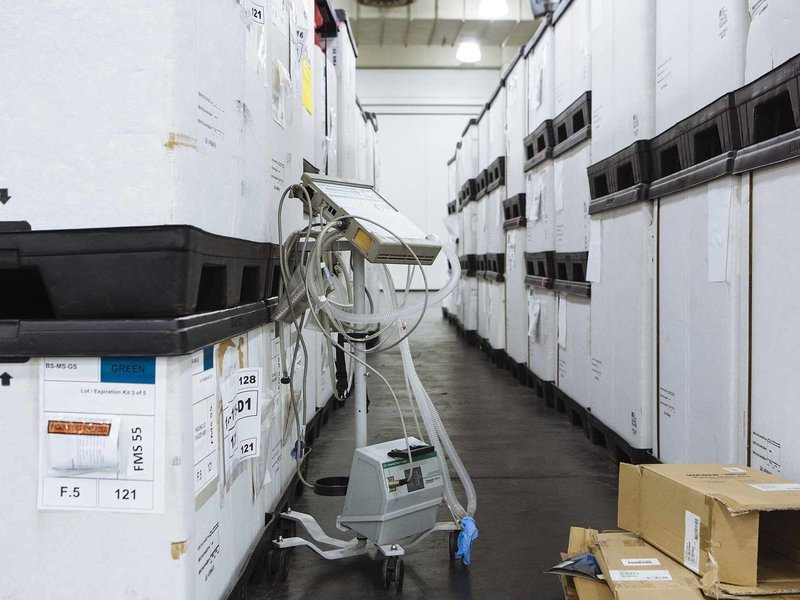
Automakers might seem unlikely candidates to build ventilators for coronavirus victims. But in fact they may be quite well-suited to churn out the highly intricate medical devices that are in critically short supply.
Consider: They have vast supply chains, are staffed with skilled engineers used to building to exacting standards and sometimes use “clean rooms” in their factories. There’s even a similarity between some components of ventilators and cars, such as hoses.
While the companies face a huge challenge to show they can meet the overwhelming demand, they likely represent the best hope for President Donald Trump and other world leaders. And now the carmakers have no choice, anyway. Days after Ford Motor Co. and General Motors Co. said they would help produce the life-saving equipment, Trump stepped up a pressure campaign and on Friday invoked federal authority to accelerate output.
The unprecedented turn to carmakers underscores the powerful role they play in the global supply chain, overseeing vast networks of companies able to procure a wide variety of parts.
“They may not know how to make the ventilators, but they may be able to offer the scale that the ventilator manufacturers cannot,” said Nada Sanders, a professor of supply chain management at Northeastern University.
Besides Ford and GM, plane maker Airbus, electric-vehicle manufacturer Tesla Inc. and vacuum innovator Dyson Ltd. have all offered to help produce ventilators. Rice University said a team of engineering students collaborated with health design firm Metric Technologies to develop a prototype of a bag-valve mask ventilator that can be built for less than $300.
Breathing trouble
Alongside face masks and hand sanitizer, ventilators have become some of the most in-demand — and hard-to-find — products across the world. The machines use tubes to deliver oxygen to the lungs to patients who have trouble breathing on their own, a critical function in the pandemic of the respiratory coronavirus known as Covid-19.
In their simplest forms, ventilators can be hand-pumped. But the devices used at patient bedsides are often complex, using microprocessors, pumping systems, alarms and other technology. Those machines can cost upwards of $40,000.
Not every patient needs a top-of-the-line ventilator, though. About half of coronavirus patients needing help breathing can use a device with simpler functionality, which could presumably be made by automakers or other companies that don’t typically specialize in medical equipment, according to Dr. Rohith Malya, an emergency physician in Houston.
“If you can engineer to a standard that’s hospital-grade, sure, go ahead,” he said. “If they have a production line and they know what they’re doing with industrial production, I don’t have a problem.”
GE Expertise
Under an agreement announced this week, General Electric Co.’s healthcare division will offer its technical expertise to Ford, with the intention of having the automaker using its factories to build a “simplified version” of a GE ventilator. While GE’s product has multiple settings that ensure optimal performance targeted to the patient, the Ford-built version will likely have a single setting to provide more basic functionality and use fewer parts.
“There’s a lot of similarities between making any kind of device and an automobile,” Carla Bailo, CEO of the Center for Automotive Research in Ann Arbor, Mich., said on Bloomberg Television. “Automakers have a huge supply base that can be engaged.”
GM has been working with Ventec Life Systems Inc. on potentially producing ventilators in Indiana. Trump on Friday invoked the Defense Production Act to force GM to make the devices, saying the company wasn’t moving fast enough. GM was frustrated over how long it was taking to finalize terms between the automaker, its partner Ventec and the federal government, said people familiar with the private deliberations.
Even with a simplified product, questions remain about whether carmakers can bring their strength to bear to produce the devices, especially as they accelerate output of something they don’t normally make. For one thing, some people, such as Royal Philips NV’s CEO Frans van Houten, have questioned whether suppliers can get all the necessary components on time.
And, of course, they’ll need to ensure the ventilators won’t harm patients, said Northeastern’s Sanders.
“With ventilators, we’re talking about some very complicated pieces of equipment,” she said. When it comes to manufacturing them to exacting specifications, “you have to be extraordinarily careful.”